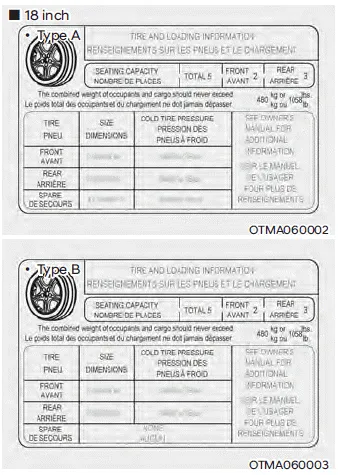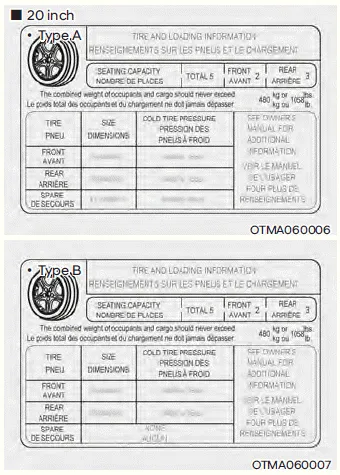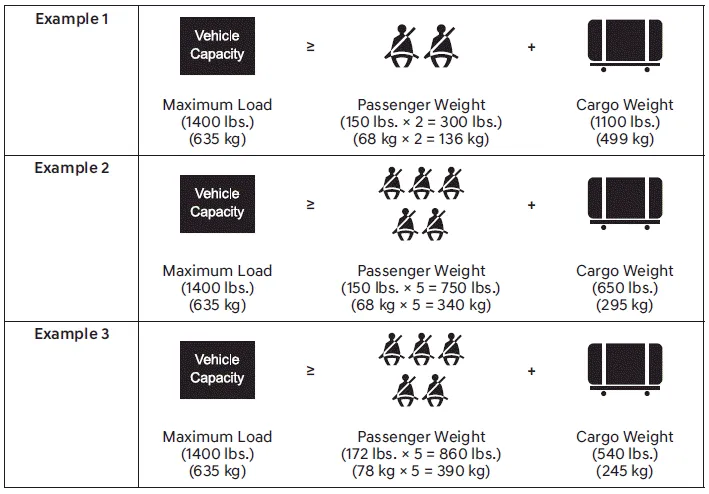Hyundai Santa Fe (TM): Vehicle load limit / The Loading Information Label



The label located on the driver’s door sill gives the original tire size, cold tire pressures recommended for your vehicle, the number of people that can be in your vehicle and vehicle capacity weight.
Vehicle capacity weight
5 persons : 903 lbs. (410 kg)
Vehicle capacity weight is the maximum combined weight of occupants and cargo. If your vehicle is equipped with a trailer, the combined weight includes the tongue load.
Seating capacity
Total : 5 persons (Front seat : 2 persons, Rear seat : 3 persons)
Seating capacity is the maximum number of occupants including a driver, your vehicle may carry. However, the seating capacity may be reduced based upon the weight of all of the occupants, and the weight of the cargo being carried or towed. Do not overload the vehicle as there is a limit to the total weight, or load limit including occupants and cargo, the vehicle can carry.
Towing capacity
With brake system (PKG OPT) : 2,000 lbs (907 kg)
With brake system (STD) : 2,800 lbs (1,270 kg) (GDI) / 3,500 lbs (1,588 kg) (T-GDI)
Towing capacity is the maximum trailer weight including its cargo weight, your vehicle can tow.
Cargo capacity
The cargo capacity of your vehicle will increase or decrease depending on the weight and the number of occupants and the tongue load, if your vehicle is equipped with a trailer.
Steps for determining correct load limit
1. Locate the statement "The combined weight of occupants and cargo should never exceed XXX kg or XXX lbs." on your vehicle's placard.
2. Determine the combined weight of the driver and passengers that will be riding in your vehicle.
3. Subtract the combined weight of the driver and passengers from XXX kg or XXX lbs.
4. The resulting figure equals the available amount of cargo and luggage load capacity. For example, if the "XXX" amount equals 1400 lbs. and there will be five 150 lb passengers in your vehicle, the amount of available cargo and luggage load capacity is 650 lbs. (1400 - 750 (5 x 150) = 650 lbs.)
5. Determine the combined weight of luggage and cargo being loaded on the vehicle. That weight may not safely exceed the available cargo and luggage load capacity calculated in Step 4.
6. If your vehicle will be towing a trailer, load from your trailer will be transferred to your vehicle. Consult this manual to determine how this reduces the available cargo and luggage load capacity of your vehicle.
WARNING
Do not overload the vehicle as there is a limit to the total weight, or load limit, including occupants and cargo, the vehicle can carry. Overloading can shorten the life of the vehicle. If the GVWR or the GAWR is exceeded, parts on the vehicle can be broken and it can change the handling of your vehicle. These could cause you to lose control and result in an accident.

Two labels on your driver’s door sill show how much weight your vehicle was designed to carry: the Tire and Loading Information Label and the Certification Label.
' The certification label is located on the driver's door sill at the center pillar and shows the maximum allowable weight of the fully loaded vehicle.
Other information:
Hyundai Santa Fe (TM) 2019-2023 Service and Repair Manual: PTC Heater (Diesel only). Repair procedures
Inspection Operating Logic Test (Manual only) Inspect the PTC operation with the confirmation logic below : 1. Entering (1) Set the mode to FLOOR. (2) Set the temperature to MAX HOT.
Hyundai Santa Fe (TM) 2019-2023 Service and Repair Manual: Specifications
Specifications [ADAS_PRK Application Specification (MOBIS)] Item Specification Ultrasonic sensor Voltage rating DC 12V Detecting range 40cm ~ 120cm Operating voltage DC 9V ~ 16V Operation curr
Categories
- Manuals Home
- Hyundai Santa Fe Owners Manual
- Hyundai Santa Fe Service Manual
- Front Radar Unit. Repair procedures
- Engine Mechanical System
- Folding the side view mirror
- New on site
- Most important about car
